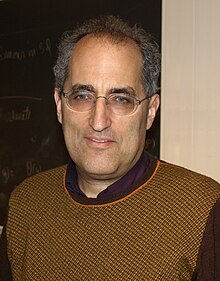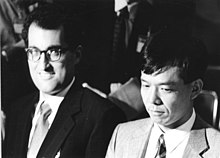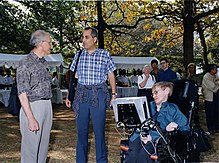Edward Witten
Edward Witten
Jump to navigation
Jump to search
Edward Witten | |
|---|---|
 Witten giving a speech at Chalmers tekniska högskola, Göteborg, Sweden, April 29, 2008 | |
| Born | (1951-08-26) August 26, 1951 Baltimore, Maryland, U.S. |
| Residence | Princeton, New Jersey, U.S. |
| Nationality | American |
| Alma mater |
|
| Known for | M-theory Seiberg–Witten theory Seiberg–Witten invariants Wess–Zumino–Witten model Weinberg–Witten theorem Gromov–Witten invariant Hořava–Witten domain wall Vafa–Witten theorem Witten index BCFW recursion Topological quantum field theory (Witten-type TQFTs) Topological string theory AdS/CFT correspondence CSW rules Witten conjecture Hanany–Witten transition |
| Spouse(s) | Chiara Nappi |
| Children | 3 |
| Awards | MacArthur Fellowship (1982) Dirac Medal (1985) Albert Einstein Medal (1985) Fields Medal (1990) Alan T. Waterman Award (1995) Dannie Heineman Prize (1998) Nemmers Prize (2000) National Medal of Science (2002) Harvey Prize (2005) Henri Poincaré Prize (2006) Crafoord Prize (2008) Lorentz Medal (2010) Isaac Newton Medal (2010) Fundamental Physics Prize (2012) Kyoto Prize (2014) Albert Einstein Award (2016)[1] |
| Scientific career | |
| Fields | Theoretical physics Superstring theory |
| Institutions | Institute for Advanced Study Harvard University Oxford University California Institute of Technology Princeton University |
| Thesis | Some Problems in the Short Distance Analysis of Gauge Theories (1976) |
| Doctoral advisor | David Gross[2] |
| Other academic advisors | Sidney Coleman[3] Michael Atiyah[3] |
| Doctoral students | Cumrun Vafa Xiao-Gang Wen Eva Silverstein Shamit Kachru Sergei Gukov Dror Bar-Natan |
| Website | www.sns.ias.edu/witten |
Edward Witten (born August 26, 1951) is an American theoretical physicist and professor of mathematical physics at the Institute for Advanced Study in Princeton, New Jersey.
Witten is a researcher in string theory, quantum gravity, supersymmetric quantum field theories, and other areas of mathematical physics.
In addition to his contributions to physics, Witten's work has significantly impacted pure mathematics.[4] In 1990, he became the first and so far the only physicist to be awarded a Fields Medal by the International Mathematical Union, awarded for his 1981 proof of the positive energy theorem in general relativity.[5]
Contents
1 Early life and education
2 Research
2.1 Fields medal work
2.2 M-theory
2.3 Other work
3 Awards and honors
4 Personal life
5 Selected publications
6 References
7 External links
Early life and education[edit]
Witten was born in Baltimore, Maryland, to a Jewish family.[6] He is the son of Lorraine (Wollach) Witten and Louis Witten, a theoretical physicist specializing in gravitation and general relativity.[7]
Witten attended the Park School of Baltimore (class of '68), and received his Bachelor of Arts with a major in history and minor in linguistics from Brandeis University in 1971. He published articles in The New Republic and The Nation. He worked briefly for George McGovern's presidential campaign.
Witten attended the University of Wisconsin–Madison for one semester as an economics graduate student before dropping out.[2] He returned to academia, enrolling in applied mathematics at Princeton University in 1973, then shifting departments and receiving a Ph.D. in physics in 1976 under David Gross,[2] the 2004 Nobel laureate in Physics. He held a fellowship at Harvard University (1976–77), visited Oxford University (1977–78),[3][8] was a junior fellow in the Harvard Society of Fellows (1977–1980), and held a MacArthur Foundation fellowship (1982).
Research[edit]
Fields medal work[edit]
Witten was awarded the Fields Medal by the International Mathematical Union in 1990, becoming the first physicist to win the prize.
In a written address to the ICM, Michael Atiyah said of Witten,[4]
.mw-parser-output .templatequote{overflow:hidden;margin:1em 0;padding:0 40px}.mw-parser-output .templatequote .templatequotecite{line-height:1.5em;text-align:left;padding-left:1.6em;margin-top:0}
Although he is definitely a physicist (as his list of publications clearly shows) his command of mathematics is rivaled by few mathematicians, and his ability to interpret physical ideas in mathematical form is quite unique. Time and again he has surprised the mathematical community by a brilliant application of physical insight leading to new and deep mathematical theorems... [H]e has made a profound impact on contemporary mathematics. In his hands physics is once again providing a rich source of inspiration and insight in mathematics.

Edward Witten (left) with mathematician Shigefumi Mori, probably at the ICM in 1990 where they received the Fields Medal
As an example of Witten's work in pure mathematics, Atiyah cites his application of techniques from quantum field theory to the mathematical subject of low-dimensional topology. In the late 1980s, Witten coined the term topological quantum field theory for a certain type of physical theory in which the expectation values of observable quantities encode information about the topology of spacetime.[9] In particular, Witten realized that a physical theory now called Chern–Simons theory could provide a framework for understanding the mathematical theory of knots and 3-manifolds.[10] Although Witten's work was based on the mathematically ill-defined notion of a Feynman path integral and was therefore not mathematically rigorous, mathematicians were able to systematically develop Witten's ideas, leading to the theory of Reshetikhin–Turaev invariants.[11]
Another result for which Witten was awarded the Fields Medal was his proof in 1981 of the positive energy theorem in general relativity.[12] This theorem asserts that (under appropriate assumptions) the total energy of a gravitating system is always positive and can be zero only if the geometry of spacetime is that of flat Minkowski space. It establishes Minkowski space as a stable ground state of the gravitational field. While the original proof of this result due to Richard Schoen and Shing-Tung Yau used variational methods,[13][14] Witten's proof used ideas from supergravity theory to simplify the argument.
A third area mentioned in Atiyah's address is Witten's work relating supersymmetry and Morse theory,[15] a branch of mathematics that studies the topology of manifolds using the concept of a differentiable function. Witten's work gave a physical proof of a classical result, the Morse inequalities, by interpreting the theory in terms of supersymmetric quantum mechanics.
M-theory[edit]
By the mid 1990s, physicists working on string theory had developed five different consistent versions of the theory. These versions are known as type I, type IIA, type IIB, and the two flavors of heterotic string theory (SO(32) and E8×E8). The thinking was that out of these five candidate theories, only one was the actual correct theory of everything, and that theory was the one whose low-energy limit matched the physics observed in our world today.
Speaking at the string theory conference at University of Southern California in 1995, Witten made the surprising suggestion that these five string theories were in fact not distinct theories, but different limits of a single theory which he called M-theory.[16][17] Witten's proposal was based on the observation that the five string theories can be mapped to one another by certain rules called dualities and are identified by these dualities.
Witten's announcement led to a flurry of work now known as the second superstring revolution.
Other work[edit]

Edward Witten with David Gross and Stephen Hawking
Another of his contributions to physics was to the result of gauge/gravity duality. In 1997, Juan Maldacena formulated a result known as the AdS/CFT correspondence, which establishes a relationship between certain quantum field theories and theories of quantum gravity.[18] Maldacena's discovery has dominated high energy theoretical physics for the past 15 years because of its applications to theoretical problems in quantum gravity and quantum field theory. Witten's foundational work following Maldacena's result has shed light on this relationship.[19]
In collaboration with Nathan Seiberg, Witten established several powerful results in quantum field theories. In their paper on string theory and noncommutative geometry, Seiberg and Witten studied certain noncommutative quantum field theories that arise as limits of string theory.[20] In another well-known paper, they studied aspects of supersymmetric gauge theory.[21] The latter paper, combined with Witten's earlier work on topological quantum field theory,[9] led to developments in the topology of smooth 4-manifolds, in particular the notion of Seiberg–Witten invariants.
With Anton Kapustin, he has made deep mathematical connections between S-duality of gauge theories and the geometric Langlands correspondence.[22] Partly in collaboration with Seiberg, one of his recent interests include aspects of field theoretical description of topological phases in condensed matter and non-supersymmetric dualities in field theories that, among other things, are of high relevance in condensed matter theory. From a generalization of SYK models from condensed matter and quantum chaos, he has also recently brought tensor models of Garau to the relevance of holographic and quantum gravity theories.
In general, Witten has done influential and insightful works in many aspects of quantum field theories and mathematical physics, including the physics and mathematics of anomalies, integrability, dualities, localization, homologies and so on. Many of his results have deeply influenced many areas in theoretical physics (often well beyond the original context of his results), including string theory, quantum gravity and topological condensed matter.
Awards and honors[edit]
Witten has been honored with numerous awards including a MacArthur Grant (1982), the Fields Medal (1990), the Nemmers Prize in Mathematics (2000), the National Medal of Science[23] (2002), Pythagoras Award[24] (2005), the Henri Poincaré Prize (2006), the Crafoord Prize (2008), the Lorentz Medal (2010) the Isaac Newton Medal (2010) and the Fundamental Physics Prize (2012). Since 1999, he has been a Foreign Member of the Royal Society (London), and in March 2016 was elected an Honorary Fellow of the Royal Society of Edinburgh.[25][26]Pope Benedict XVI appointed Witten as a member of the Pontifical Academy of Sciences (2006). He also appeared in the list of TIME magazine's 100 most influential people of 2004. In 2012 he became a fellow of the American Mathematical Society.[27]
In an informal poll at a 1990 cosmology conference, Witten received the largest number of mentions as "the smartest living physicist".[28]
Personal life[edit]
Witten has been married to Chiara Nappi, a professor of physics at Princeton University, since 1979.[29] They have two daughters, Ilana, a neuroscientist at Princeton University,[30] and Daniela, a biostatistician at University of Washington,[31] and one son, Rafael, and a granddaughter Nava. Witten sits on the board of directors of Americans for Peace Now and is also on the advisory council of J Street.[32] He supports the two-state solution and advocates a boycott of Israeli institutions and economic activity beyond its 1967 borders, though not of Israel itself.[33] Witten is also a keen tennis player.[34]
Selected publications[edit]
Some Problems in the Short Distance Analysis of Gauge Theories. Princeton University, 1976. (Dissertation.)
Roman Jackiw, David Gross, Sam B. Treiman, Edward Witten, Bruno Zumino. Current Algebra and Anomalies: A Set of Lecture Notes and Papers. World Scientific, 1985.
Green, M., John H. Schwarz, and E. Witten. Superstring Theory. Vol. 1, Introduction. Cambridge Monographs on Mathematical Physics. Cambridge, UK: Cambridge University Press, 1988. .mw-parser-output cite.citation{font-style:inherit}.mw-parser-output q{quotes:"""""""'""'"}.mw-parser-output code.cs1-code{color:inherit;background:inherit;border:inherit;padding:inherit}.mw-parser-output .cs1-lock-free a{background:url("//upload.wikimedia.org/wikipedia/commons/thumb/6/65/Lock-green.svg/9px-Lock-green.svg.png")no-repeat;background-position:right .1em center}.mw-parser-output .cs1-lock-limited a,.mw-parser-output .cs1-lock-registration a{background:url("//upload.wikimedia.org/wikipedia/commons/thumb/d/d6/Lock-gray-alt-2.svg/9px-Lock-gray-alt-2.svg.png")no-repeat;background-position:right .1em center}.mw-parser-output .cs1-lock-subscription a{background:url("//upload.wikimedia.org/wikipedia/commons/thumb/a/aa/Lock-red-alt-2.svg/9px-Lock-red-alt-2.svg.png")no-repeat;background-position:right .1em center}.mw-parser-output .cs1-subscription,.mw-parser-output .cs1-registration{color:#555}.mw-parser-output .cs1-subscription span,.mw-parser-output .cs1-registration span{border-bottom:1px dotted;cursor:help}.mw-parser-output .cs1-hidden-error{display:none;font-size:100%}.mw-parser-output .cs1-visible-error{font-size:100%}.mw-parser-output .cs1-subscription,.mw-parser-output .cs1-registration,.mw-parser-output .cs1-format{font-size:95%}.mw-parser-output .cs1-kern-left,.mw-parser-output .cs1-kern-wl-left{padding-left:0.2em}.mw-parser-output .cs1-kern-right,.mw-parser-output .cs1-kern-wl-right{padding-right:0.2em}
ISBN 9780521357524.- Green, M., John H. Schwarz, and E. Witten. Superstring Theory. Vol. 2, Loop Amplitudes, Anomalies and Phenomenology. Cambridge, UK: Cambridge University Press, 1988.
ISBN 9780521357531.
Quantum fields and strings: a course for mathematicians. Vols. 1, 2. Material from the Special Year on Quantum Field Theory held at the Institute for Advanced Study, Princeton, NJ, 1996–1997. Edited by Pierre Deligne, Pavel Etingof, Daniel S. Freed, Lisa C. Jeffrey, David Kazhdan, John W. Morgan, David R. Morrison and Edward Witten. American Mathematical Society, Providence, RI; Institute for Advanced Study (IAS), Princeton, NJ, 1999. Vol. 1: xxii+723 pp.; Vol. 2: pp. i–xxiv and 727–1501.
ISBN 0-8218-1198-3, 81–06 (81T30 81Txx).
References[edit]
^ "Announcement of 2016 Winners". World Cultural Council. June 6, 2016. Archived from the original on June 7, 2016. Retrieved June 6, 2016.
^ abc Woit, Peter (2006). Not Even Wrong: The Failure of String Theory and the Search for Unity in Physical Law. New York: Basic Books. p. 105. ISBN 0-465-09275-6.
^ abc Edward Witten – Adventures in physics and math (Kyoto Prize lecture 2014)
^ ab Atiyah, Michael (1990). "On the Work of Edward Witten" (PDF). Proceedings of the International Congress of Mathematicians. pp. 31–35. Archived from the original (PDF) on 2017-03-01.
^ Michael Atiyah. "On the Work of Edward Witten" (PDF). Mathunion.org. Archived from the original (PDF) on 1 March 2017. Retrieved 31 March 2017.
^ Witten biography - MacTutor History of Mathematics
^ The International Who's Who 1992-93, p. 1754.
^ Interview by Hirosi Ooguri, Notices Amer. Math. Soc., May 2015, pp. 491–506.
^ ab Witten, Edward (1988), "Topological quantum field theory", Communications in Mathematical Physics, 117 (3): 353–386, Bibcode:1988CMaPh.117..353W, doi:10.1007/BF01223371
^ Witten, Edward (1989). "Quantum Field Theory and the Jones Polynomial" (PDF). Communications in Mathematical Physics. 121 (3): 351–399. Bibcode:1989CMaPh.121..351W. doi:10.1007/BF01217730.
^ Reshetikhin, Nicolai; Turaev, Vladimir (1991). "Invariants of 3-manifolds via link polynomials and quantum groups". Inventiones Mathematicae. 103 (1): 547–597. Bibcode:1991InMat.103..547R. doi:10.1007/BF01239527.
^ Witten, Edward (1981). "A new proof of the positive energy theorem". Communications in Mathematical Physics. 80 (3): 381–402. Bibcode:1981CMaPh..80..381W. doi:10.1007/BF01208277.
^ Schoen, Robert; Yau, Shing-Tung (1979). "On the proof of the positive mass conjecture in general relativity". Communications in Mathematical Physics. 65: 45. Bibcode:1979CMaPh..65...45S. doi:10.1007/BF01940959.
^ Schoen, Robert; Yau, Shing-Tung (1981). "Proof of the positive mass theorem. II". Communications in Mathematical Physics. 79 (2): 231. Bibcode:1981CMaPh..79..231S. doi:10.1007/BF01942062.
^ Witten, Edward (1982). "Super-symmetry and Morse Theory". Journal of Differential Geometry. 17: 661–692.
^ University of Southern California, Los Angeles, Future Perspectives in String Theory, March 13-18, 1995, E. Witten: Some problems of strong and weak coupling
^ Witten, Edward (1995). "String theory dynamics in various dimensions". Nuclear Physics B. 443 (1): 85–126. arXiv:hep-th/9503124. Bibcode:1995NuPhB.443...85W. doi:10.1016/0550-3213(95)00158-O.
^ Juan M. Maldacena (1998). "The Large N limit of superconformal field theories and supergravity". Advances in Theoretical and Mathematical Physics. AIP Conference Proceedings. 2: 231–252. arXiv:hep-th/9711200. Bibcode:1998AdTMP...2..231M. doi:10.1063/1.59653.
^ Edward Witten (1998). "Anti-de Sitter space and holography". Advances in Theoretical and Mathematical Physics. 2: 253–291. arXiv:hep-th/9802150. Bibcode:1998AdTMP...2..253W.
^ Seiberg, Nathan; Witten, Edward (1999). "String Theory and Noncommutative Geometry". Journal of High Energy Physics. 1999 (9): 032. arXiv:hep-th/9908142. Bibcode:1999JHEP...09..032S. doi:10.1088/1126-6708/1999/09/032.
^ Seiberg, Nathan; Witten, Edward (1994). "Electric-magnetic duality, monopole condensation, and confinement in N=2 supersymmetric Yang-Mills theory". Nuclear Physics B. 426 (1): 19–52. arXiv:hep-th/9407087. Bibcode:1994NuPhB.426...19S. doi:10.1016/0550-3213(94)90124-4.
^ Kapustin, Anton; Witten, Edward (2006-04-21). "Electric-Magnetic Duality And The Geometric Langlands Program". arXiv:hep-th/0604151.
^ "Edward Witten", The President's National Medal of Science: Recipient Details.
^ "Il premio Pitagora al fisico teorico Witten". Il Crotonese (in Italian). September 23, 2005. Archived from the original on 2011-07-22.
^ "Foreign Members", The Royal Society.
^ https://www.royalsoced.org.uk/1200_2016ElectedFellows.html
^ List of Fellows of the American Mathematical Society, retrieved 2013-09-01.
^ Lemonick, Michael (April 26, 2004). "Edward Witten". Time. Retrieved November 1, 2011.
"At a 1990 conference on cosmology," wrote John Horgan in 2014, "I asked attendees, who included folks like Stephen Hawking, Michael Turner, James Peebles, Alan Guth and Andrei Linde, to nominate the smartest living physicist. Edward Witten got the most votes (with Steven Weinberg the runner-up). Some considered Witten to be in the same league as Einstein and Newton." See "Physics Titan Edward Witten Still Thinks String Theory 'on the Right Track'". scientificamerican.com. 22 September 2014. Retrieved 14 October 2014.
^ Witten, Ed. "The 2014 Kyoto Prize Commemorative Lecture in Basic Sciences" (PDF). Retrieved 28 January 2017.
^ "Faculty » Ilana B. Witten". princeton.edu. Retrieved 18 November 2016.
^ "UW Faculty » Daniela M. Witten". washington.edu. Retrieved 9 July 2015.
^ "Advisory Council". J Street. 2016. Retrieved 2016-10-14.
^ "For an Economic Boycott and Political Nonrecognition of the Israeli Settlements in the Occupied Territories", NYRB, October 2016.
^ "Jewish American Physicist Says He'll Send Part of $3 Million Prize to J Street". JTA. 4 August 2012. Retrieved 18 March 2017 – via haaretz.com.
External links[edit]
| Wikimedia Commons has media related to Edward Witten. |
| Wikiquote has quotations related to: Edward Witten |
- Faculty webpage
- Publications on ArXiv
O'Connor, John J.; Robertson, Edmund F., "Edward Witten", MacTutor History of Mathematics archive, University of St Andrews.
Edward Witten at the Mathematics Genealogy Project
- A Physicist’s Physicist Ponders the Nature of Reality, Interview with Nathalie Wolchover in Quanta Magazine, 28th November, 2017
Categories:
- 1951 births
- 20th-century physicists
- 21st-century physicists
- Albert Einstein Medal recipients
- Albert Einstein World Award of Science Laureates
- American physicists
- Brandeis University alumni
- Clay Research Award recipients
- Fellows of the American Mathematical Society
- Fields Medalists
- Foreign Members of the Royal Society
- Harvard Fellows
- Institute for Advanced Study faculty
- ISI highly cited researchers
- Jewish American scientists
- Jewish physicists
- Kyoto laureates in Basic Sciences
- Living people
- MacArthur Fellows
- Mathematical physicists
- Members of the French Academy of Sciences
- Members of the Pontifical Academy of Sciences
- Members of the United States National Academy of Sciences
- National Medal of Science laureates
- Lorentz Medal winners
- Scientists from Baltimore
- Princeton University alumni
- Princeton University faculty
- String theorists
- Theoretical physicists
- Members of the American Philosophical Society
- Fellows of the American Academy of Arts and Sciences
- Breakthrough Prize winners
(window.RLQ=window.RLQ||).push(function(){mw.config.set({"wgPageParseReport":{"limitreport":{"cputime":"0.760","walltime":"0.957","ppvisitednodes":{"value":3921,"limit":1000000},"ppgeneratednodes":{"value":0,"limit":1500000},"postexpandincludesize":{"value":143941,"limit":2097152},"templateargumentsize":{"value":9268,"limit":2097152},"expansiondepth":{"value":14,"limit":40},"expensivefunctioncount":{"value":13,"limit":500},"unstrip-depth":{"value":1,"limit":20},"unstrip-size":{"value":81163,"limit":5000000},"entityaccesscount":{"value":4,"limit":400},"timingprofile":["100.00% 780.116 1 -total"," 36.23% 282.638 1 Template:Reflist"," 24.80% 193.432 1 Template:Infobox_scientist"," 23.61% 184.200 1 Template:Infobox_person"," 20.57% 160.508 2 Template:Infobox"," 11.44% 89.274 9 Template:Cite_web"," 10.72% 83.652 11 Template:Cite_journal"," 10.19% 79.499 3 Template:Isbn"," 8.79% 68.573 4 Template:Navbox"," 8.37% 65.259 1 Template:Authority_control"]},"scribunto":{"limitreport-timeusage":{"value":"0.332","limit":"10.000"},"limitreport-memusage":{"value":6039342,"limit":52428800}},"cachereport":{"origin":"mw1323","timestamp":"20181130143647","ttl":1900800,"transientcontent":false}}});mw.config.set({"wgBackendResponseTime":124,"wgHostname":"mw1325"});});

